��353�`
�b�g�`�o�s�d�q �@�w�Y
Liturgical
Polyphony in the
Fourteenth
Century
14���I�̑����~�T�Ȃ̊e�͂́A�T�特�y�̓�����̏��l������Ȃ�������B���j�Ƃ͈�ʓI�ɁA������|�p�ɂ����āA���������i�����ł���A�Ƃ݂Ȃ��X���ɂ���B�����Ă����́A����������Ԃ��A�@���I�A�o�ϓI�w�i�ɂ����Đ�������B
���c�̃A�r�j�����ɂ�����h�o�r�����̕ߎ��h�i1305-78)�ƃV�X�}(1378-1417)�̂Ƃ��̋��c�̕����̃��C�o�������ɔ��Ȃ��A����̌��͂ƈЌ��͒������n�ɗ����Ă����B����A�s�������̕x�̑���́A�������z�A�G��A�����A���y�Ȃǂւ̐V�����s���n�o�����B
�m���ɁA���������v�f�͐��������̐i�W�̕����I�ȗv���ɂ͂Ȃ��Ă��邾�낤�B�������A����̂����Ƃ��Ⴂ�����ł����A�|�p�̕ی����߂邱�Ƃ͂Ȃ������B���y�̑����̗��j�Ƃ͂����炭�A������i���ߑ�]�����Ă���B���j�I�����́A�ǂ���̉��y�I���j�������g�������c��̂��A�ǂ��炪�ŏ��ɋߑ�ɒm����悤�ɂȂ�̂��A�����肵���B�䂦�ɁA�}�V���[��C�^���A�̍�ȉƂ̍�i�ɂ�����悤�Ȉ��|�I�Ȑ����I�|���t�H�j�[�̗D�ʐ��́A14���I�S�̂̓T�^�ł���Ƃ݂Ȃ����悤�ɂȂ����B
�s�K�Ȃ��ƂɁA���c���n�l22���̗L���Ȓ����͂��̌��ۂ̈��ՂȐ������\�ɂ����B�A���B�j������1324�N�ɏo����A�����͋������ƂŁA�ׂ��������𑽐��g���A������z�P�b�g����ȃ|���t�H�j�[�ŋ���̃����f�B���䂪�߂���ȉƂ�����B�̎肽���͔ނ�̉̂≹�y�̊����\�����邽�߂ɃW�F�X�`���[���g�����Ƃ���ꂽ�B
�����͂���������������H���֎~���A�֎~�����Ȃ������ꍇ�ɂ͔������Ȃ����B�����ȋ@��ɂ����Ă̂݁A�킸���Șa���A�I�N�^�[�u�A�ܓx�A�l�x�݂̂���q���ʂ����B�����f�B�͌��܂������̂ŁA�����̂Ȃ��悤�Ȃ��̂ł������B
�@Ars
noza�̊v�V�ɑ��锽���L�^���������Ƃ��āA���c���n�l22���̒����́A���ȋ����[���������Ă��邪�A���y�̔��W�̋�̌��ʂ́A����߂ĉߑ�]�����Ȃ���Ă���B
�ʏ�A����͑����̃I���K�k���̂����Ƃ��P���Ȍ`���݂̂�������A���Ȃ鉹�y�̎Y���́A��ȉƂ������ނ�̈Ӑ}�𐢑��I�`���ւƓ]�����邱�Ƃ���߂����悤�Ƃ����B�����������������Ă���l�́A13���I�ɋN���������Ƃ����߂����Ă���B�g�����F�[���̑����̃��p�[�g���[�Ɛ����t�����X��̑����̃��e�b�g�́A�����I���y�ւ̊S�����n�l�̒����̔��߂�҂��Ȃ���Ȃ�Ȃ������Ƃ��鉼��ɔ�������̂ł���B
����ɉ�X���m�����A�T��I�|���t�H�j�[�̍�Ȃ́A����ɐ旧��100�N�ԁA�قƂ�ǖ�������Ă����B���Ȃ��Ƃ��������̏ꏊ�ŁA�m�[�g���_���I���K�k����14���I�܂Ŏg���Ă����B�����āA���e���ꃂ�e�b�g�͋^���Ȃ��A�����q���Ō��o���ꂽ�B����̃t�����X�ꃂ�e�b�g�ł����A�@���I���Ђ̕s�����ؖ������悤�ɁA�Ƃ��ǂ��͉��t���ꂽ�B�V�������y���ǂ̂悤�ɓT�������A���̕i�ʂ𗎂Ƃ����ƁA�����������y�́A���炩�ɁA�����ȏ@���I�e�L�X�g�̐V�����|���t�H�j�[�ݒ���܂�ł��Ȃ������B���������ݒ�͏��Ȃ��Ƃ��A
�m�[�g���_���y�h��14���I���܂ł̊��Ԃɑ��݂������y�����ɂ͑��݂��Ȃ������B
����䂦�A���c���n�l22�������Ȃ鉹�y�̍�Ȃ̌����̌����ƂȂ����Ƃ��������́A�قƂ�ǐ������Ȃ��B�ނ��낻�̌��ʂ̂Ȃ����������Ă�����������Ȃ��B�C�����A�ʖ{�́A�i�ߎ��̂������j20�N���邢��25�N�̊ԂɁA�T��I�|���t�H�j�[���Đ����ꂽ�̂ł͂Ȃ��A�A���B�j�������g�ʼnh�������Ƃ��ؖ����Ă���B�A���B�j��������̕ʂ́A�����Ԃ����̉��y�ɂ́A�����ăC�����A�ʖ{�ɂ́A��ʓI�Ȃ������̍�i�����邪�A�A�v�g�ʖ{���܂��A15���I�O���Ɋg�債����ȉƂ����ɂ�邢�����̍�i���������Ă���B
�T��I�|���t�H�j�[�̂�菬���ȃR���N�V�����̐��X�́A���炩�ɁA�A���B�j�����̊O���̉��y�̊m���ɂ��̋N���������Ă����B�������A�قƂ�Ǘ�O�Ȃ��A�������������͏��Ȃ��Ƃ��A�C�����A�ʖ{���邢�̓A�v�g�ʖ{���Ɍ��o������i�̂ЂƂ��܂�ł���B����䂦�A���[�}���c��q�����T���Ȑ��@�������C�o���̗�q���́A�A���B�j������T��I�|���t�H�j�[�̒��S�����ɂ���悤�ȓ�����}�����B�ŋ߂̌����́A14���I�̉��y���A����܂ōl�����Ă����悤�ɁA�����āA�������y���x�z�I�Ƃ����킯�ł͂Ȃ��������Ƃ𖾂炩�ɂ��Ă���B
MASS
MOVEMENTS
��ȉƂ������A1���I���邢�͂���ȏ�߂�����̓T��e�L�X�g�̐ݒ�ɖ߂������A�ނ�̉��y�́A�T��I�|���t�H�j�[�̌Â��`���A�l���Ƃ͑����̓_�ŁA�قȂ������̂ƂȂ��Ă����B�قڗ�O�Ȃ��A�m�[�g���_���y�h�̓I���K�k���̍�Ȃ��A�������ۂ�~�T�̌ŗL���ɑ��鉞�����̂̃\������ɐ������Ă������A14���I�ɂ́A�~�T�̒ʏ핶�̃e�L�X�g������I�Ȓ��ڂ𗁂тĂ����B�������������_�̃V�t�g�́A�����I�ɂ́A�����ɂ����ĔN1���̂��Ȃ������ŗL���Ɣ�r���āA�ʏ핶�̃e�L�X�g�̂�葽���̎g�p�̌��ʂł������ɈႢ�Ȃ��B
�������A���������V�t�g�͂܂��A�T��I�|���t�H�j�[�̋@�\���g�̐�����@�\�ɂ�����ω��f�Ȃ����A�\�����Ă����B�������̂ƈقȂ�A�ʏ핶�̃e�L�X�g�͒Z���\���̃C���g�[����ɁA���̑��ɂ���ĉ̂�ꂽ�B�������̏ꍇ�A14���I�̃~�T�y�͂́A���l�b�T���X���̍����~�T�Ȃ̒��_�ƂȂ����A�\���X�g�I�|���t�H�j�[�̓]����\�����Ă����B
����
�@�����������̂����ł̊S�́A�|���t�H�j�[�~�T�̊y�͂̃R���N�V�����ƂƂ��ɁA�Ɨ����A�݂��ɖ��W�Ȓʏ핶�̊y�͂̐ݒ�ɂ��Ăł���B���������ݒ�́A�|���t�H�j�[�����̏�������F�߂��邪�A�����͂��ɎU�킵�āA�������Ȃ��B�����đ啔���́A�L���G�̂悤�Ȓʏ핶�̂��Z�����ڂł���B
�C�����A�ʖ{�́A�O�����A��N���h���D�ʂ̃~�T�̍��ڂ̑�K�͂ȃR���N�V������ێ����Ă���B���̂Q�T��i�́A�S�̃L���G�A�Q�̃T���N�g�D�X�A������A�A�j���X�f�C�͊܂܂�Ă��Ȃ��B�c��̓O�����A�ƃN���h�ł���A���ꂼ��X����A����Ƀ��m�t�H�j�[�̃N���h���P�Ȃ���B
THREE STYLES OF POLYPHONIC MASS
MOVEMENTS
�m�[�g���_���I���K�k���̌o�߂ƒʏ핶�e�L�X�g�ݒ�ɂ�����V�����S�́A14���I�̃~�T�Ȋy�͂�14���I�̍�ȉƂ������A�]���ׂ��T��|���t�H�j�[�̌p���I�ȓ`�����Ȃ����Ƃ��Ӗ����Ă����B�ނ�́A���Ȃ�|���t�H�j�[������ŋ�ʓI�ȉ��y�l�������߂������Ȃ銴��ɂ���Ă��A�������W�����邱�Ƃ͂Ȃ������B����䂦�A�ނ炪������̃|���t�H�j�[�Ŋ���Ă����̂Ƃ͕ʂ̗l�����g�����ƂŃ~�T�y�͂����������Ƃ́A�����ɂ͓�����Ȃ��B
���������l���̂ЂƂ́A���e�b�g�ɗR������B�����|���t�H�j�[�̐�����i�̐V�����l���A�R�Ԗڂ̗l���̊����͂͂����肵�Ȃ����A����͎��Ɂhconductus�l���h�ƌĂꂽ�B���������̎���x��̒���conductus�̗R���͂͂����肵�Ȃ��B�����炭�A�h�i�e�����j�������̗l���h�́A�����̃|���t�H�j�[�̉��t�������ꂽ�`�Ŏ������̂ł��낤�B
�C�����A�ʖ{�̂��ꂼ��̍ŏ��̐����߂́A������3�̗l����������Ă���B
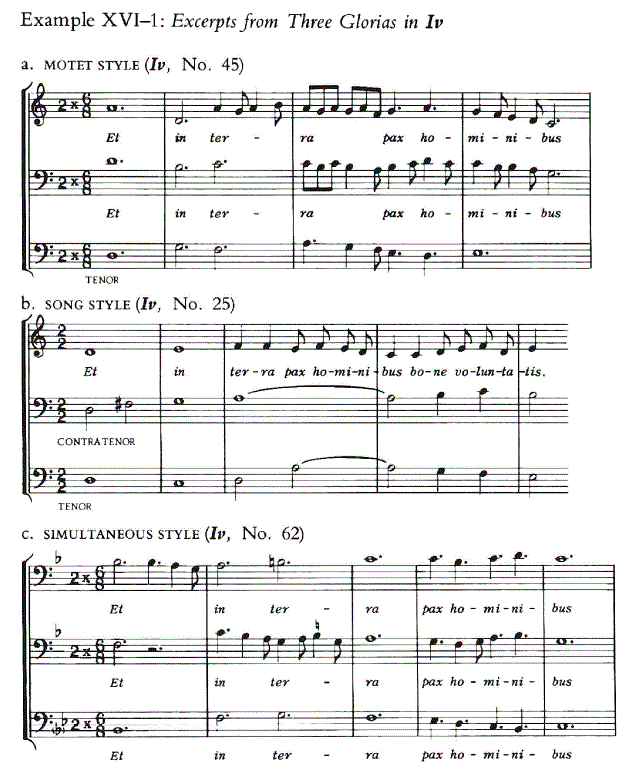
MOTET
STYLE
14���I�̏����ɍL���J�ꂽ�|���t�H�j�[���y�̗B��̗l���Ƃ��āA���e�b�g�́A�~�T�Ȃ̍��ڂ̍�Ȃɂ�����x�z�I�e�����y�ڂ����B���̉e���́A�C�����A�ʖ{���̂Q�T�̍��ڂŖ��炩�ł���B����15�ȏオ���e�b�g�l���ŏ�����Ă���B���̂���10�̓e�L�X�g������Ă��Ȃ��e�m�[�����duplum��triplum������A�T�̓e�L�X�g�̂Ȃ��R���g���e�m�[��������A�S���ł���B�����̍��ڂ̑����́A���㐺���ɓ����e�L�X�g�������Ă��邱�ƂŁA�^�̃��e�b�g�Ƃ͌����Ȃ��B�������������̏ꍇ�ł́A�g���[�v�X�̑��݂����ɁA��������ʂ̃e�L�X�g�Ƃ��Ă���B
�O�����A�ɂ͂��镁�ʂł͂Ȃ��Ⴊ����B����ɂ́Atriplum�ɂ�����ʏ�̃e�L�X�g��duplum�ɂ������蒷�����e����̎��i�N�������g�S���i1342�|1352�j���]�������j��������Ă���B�ʏ핶�̂��Z�����ڂɂ́A�I���W�i���ȃe�L�X�g�ɈقȂ����g���[�v�X���������邱�Ƃ���������A�㐺���́A�������邢�͈قȂ������t���̂��Ă���B
���ɂ́A���e�b�g�ւ̗ގ��������ɋ������߂ɁA��i�͈قȂ������ނɂȂ邱�Ƃ�����B���ɁAite,missa
est ��Benedicamus
Domino���g�����^�̃��e�b�g�ł��ꂪ�F�߂���B�C�����A�ʖ{�ł̂��̂悤�ȍ�i�́A�t�����X���triplum,���e�����duplum�������A�e�m�[����ite,missa
est
�̃e�L�X�g�������Ă���B���̃P�[�X�ł́A�i�㐺���́j�ǂ���̃e�L�X�g���A�T��I��ȂƂ͖��W�ł���A����䂦�A�g���[�v�X�Ƃ͌��Ȃ���Ȃ��B�������������͐�������A�����I�w���~�����߂������Ă��A�~�T�̏I���ɑ��ẮA���܂��Ⴂ�̂��̂ł͂Ȃ���������Ȃ��B
�����悤�ȋ@�\�́A���炩�ɁA�C�����A�ʖ{�́h���e�b�g�hPost
missarum sollemnia -Post misse
modulamina�ɑ��Č������Ă���B�����̃e�L�X�g�ɂ́Aite,missa est ��Benedicamus
Domino�h�̉����ł���Deo
gratias"�̌��t�ƂƂ��ɏI���g�債���g���[�v�X������B
���y�I�\���ɂ����āA���̍�i�́A�R���ł̉��t���\�ȕt�����ꂽ�B��̃e�m�[�������A�S���̃C�\���Y�����e�b�g�ł���B�I���W�i���ȃe�m�[���́A���肳�ꂽ�e�L�X�g��v���C���\���O�͂Ȃ��B�����ł������Ƃ��Ă��A�m���Ă��Ȃ����̂ł���B�ɂ�������炸�^���Ȃ��A���e�b�g��14���I�̓T��I�|���t�H�j�[�̑��̗�Ɠ����ł���B
�@���e�b�g�l���̑����̃~�T�Ȃ̊y�͖ڂ́A�����ň��p����������̃��e�b�g����͐藣�����B���̂ɂ��e�m�[����C�\���Y���\���͋H�ł���A���㐺���͒ʏ�A�����e�L�X�g���̂��B���q�����悤�ɁB�ᐺ���́A��������蒷�������œ������A���ׂĂ̐����͈ꏏ�ɏI�~����X���ɂ���B����䂦�ɁA�~�T�Ȃ̍��ڂ̌X�̐����́A�^�̃��e�b�g���͂��Ⴂ���Y���I���l���A�Ɨ����������Ă���A�e�m�[���̓e�L�X�g�̓���Ȑݒ�ɍ����悤�ɍ�Ȃ���Ă���B
�T���āA�~�T�Ȃ̍��ڂ́A�A���I�`���Ƃ������́A�����`���Ƃ����_�ɂ����āA���e�b�g�Ƃ͈قȂ��Ă���B�L���G�ƃA�j���X�f�C�̔�������e�L�X�g�́A���R��3�̉��y�Z�N�V�����ƂȂ�A�T���N�g�D�X�͒ʏ�A�x�l�f�B�N�g�D�X�Ƃ̊W�ŁA���Ȃ��Ƃ��Q�����ƂȂ�B�قڗ�O�Ȃ��A�����̍��ڂł́A�����́A���ׂĂ̐����ɂ����āA��d�c������ɗ���Alongs�̃J�f���c�ŏI���ƂȂ�B�O�����A�ƃN���h�ł́A�����̏ꍇ�A�����悤�ɍו�������邪�A����͂���قǃV�X�e���I�ł͂Ȃ��B���e�L�X�g�̈�ʓI��舵���́A�R�̑�Z�N�V�����{�A�[�����ł���B�����͕K�����������ꏊ�ŋN����킯�ł͂Ȃ��B
�O�����A�ƃN���h�ŋN���鋻���[�������̂ЂƂ́A�傫���y�͓��ɂ������Ǔ_�̖������ʂ����悤�ȁA�P�C�Q���ߕ��̃e�L�X�g�̂Ȃ��ԑt�ł���B���������ԑt�͒ʏ�A�g�ݍ��킹�̕ω��ɂ����āA�Q�����݂̂łł��Ă���B�R���̊y�͂ɂ����ẮA���̂��߂ɁA�P������g�ݍ��݁A���邢��2����������g�ݍ��ނ��ƂɂȂ�B�����́A��y�ł������Ƃ��l�����邪�A�㐺�����邢�͕����̐������Z�������X�}�I�Ȋԓ����Ƃ��ĉ̂�ꂽ�ƍl���邱�Ƃ��\�ł���B
��蒷�������X�}�́A�������̊y�͂̒����Z�N�V�������I�~����B���ƂɃN���h��A�O�����A�ƃN���h�̃A�[�����ł́A�����L���ꂽ�����X�}�ݒ肪����B�������������X�}�̑����̓_�ɂ�����z�P�b�g�̉ߓx�̎g�p�́A�����ɋ��c���n�l�̔��Y�ꋎ���Ă������������ł��悤�B
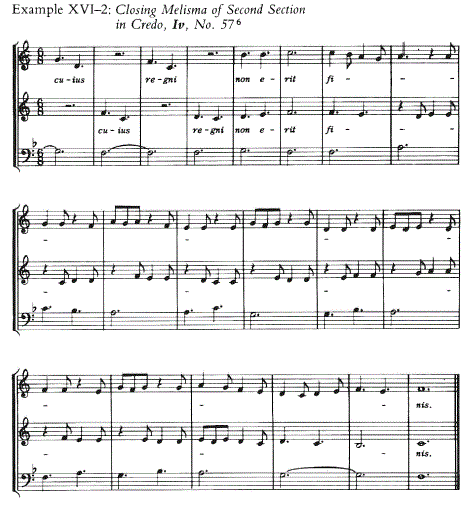
SONG
STYLE
������i�ɓK���ȓƓ��̃|���t�H�j�[�l���̑n���́A�啔���A14���I�O���ɂ�����}�V���[�̋Ɛтł���B�}�V���[�̃o���[�h�A�����h�[�A���B�����[���́A�ނ�1377�N�̎���ɂ�100�N�ȏ���W���ł��葱����3���z�u�̌��ѓ��l�A���̗l���̌`���i�K���������B�{���I�ɁA�V�����l���́A���t�̂Ȃ��e�m�[���p�[�g���x���Ă���\���\���O�icantus)����Ȃ�B���̂Q�����̘g�\���͒P�ƂŐ��藧���Ă��邪�A�����e�L�X�g�̂Ȃ������ЂƂ̐����A�J�E���^�[�e�m�[�����A�\���\���O�̔��t�Ƃ��āA�����Ƙa���I�L�����������邱�ƂɂȂ��B���������\���O�X�^�C���̐^�V�����́A�^���Ȃ��A�C�����A�ʖ{�̃~�T�Ȃ̊y�͂̂����̂U�ł̂ݖ��炩�ł���B14���I�̑啔���̎����ɂ����ẮA����́A���e�b�g�l����T��I�|���t�H�j�[�ɍD�܂����`�ւƒu���������Ă���B
�@�C�����A�ʖ{���̂U��i�̂����Q�́A�ŏ��̕����ɂ̂݉��y�����S�ɂ����Ă���L���G�ł���B����i�́A�P���ȂQ����i�ł���B���̑��̂S��i�́A�Q�̓O�����A�A�Q�̓N���h�ł���A�R���̕W���I�z���ƂȂ��Ă���B�ЂƂ̃O�����A�͈ꕔ��O�������āA�A�������ݒ�ƂȂ��Ă���B�ЂƂ̌J��ǂ́AAmen�������A�A���I�ł���B����i�Ƃ��ɁA�Q�̒ᐺ���͂P�C�Q���߂̊ԑt�ŋ���Ă���B���������ԑt�́A���e�b�g�⓯���I�l���ł͕��ʂł��邪�A�\���O�X�^�C���ł͋H�ł���B�����͂��̑��̃O�����A��N���h�ł͌������炸�A�����ׂ̍��������{�ɕ������Ă���B���������Z�N�V�����́A���e�b�g�l���̒����Z�N�V�����̂悤�ɁAlongs�̋����J�f���c�ŏI�~���Ă���B�����āA�݂��ɓ�d�c���ł��݂����������Ă���B
�O�����A�ƃN���h�̑����̍ו������\���O�X�^�C���ɂ�����e�y�͂̓T�^�ƂȂ������Ƃ̐����͍���ł���B�����炭���������l���́A�������ꂽ���̑�����ɕ������ꂽ�̎肽���ɂ���ĕ������ꂽ�����`���Ŏg��ꂽ�̂ł��낤�B�O���S���I���̂̃O�����A�́A�ʏ킱�̂悤�ɉ̂�ꂽ���A�N���h�ɂ����l�ɍs��ꂽ�B����䂦�A�|���t�H�j�[�~�T�Ȃ̊e�y�͂ł̉̂�ꂽ�����I�̂��������邱�Ƃ́A���R�Ȃ��Ƃł������B�����̐��̑��͏������A���e�b�g�l���̂Q�����⓯���l���̂R�`�S���ʼn̂����Ƃɂ����āA���݂ɂQ�O���[�v����邱�Ƃ͍���ł������B
�\���O�X�^�C���̒P���ȃ����f�B�[�ɂ͂�����������͐����Ȃ��B�ǂ̂悤�Ƀ~�T�Ȃ̊e�y�͂����낢��ȗl����14���I�ɉ��t���ꂽ�̂��A�����āA�����������H���A�^����ꂽ����ꏊ�ŁA���y�I�����ɂ���ĕω������̂��ǂ����ɂ��Ă̊m�M�͂Ȃ��B
�ɂ�������炸�������A�\���O�X�^�C���ł̊y�͂́A�\���̎�̂��߂ɂ́A���������Ȃ��������Ƃ��m���ł��낤�B���I���܂łɁA�����I�|���t�H�j�[�ɂ�����\���\���O�́A���łɏ\�����k�ō��x�ȃ����X�}�l���W�����Ă����B����͂܂��Ȃ��A����ׂ����Y���I���G���������ƂɂȂ����B
����A�T��I�|���t�H�j�[�ɂ����ẮA�\���O�X�^�C���̓��Y���̓����I�P�������̂����Ă���AAmen�������A�قƂ�ǃV���r�b�N�ȃe�L�X�g�ݒ�ł������B���̗l���̊y�͂̂قƂ�ǂ́A���ɍT���߂Ȕ\�͂̐��̑��ɂ���ĊȒP�ɉ��t���邱�Ƃ͂ł��Ȃ������B�������t�̕����I�؋��́A15���I�����Ɍ�����B�����≞���̉��t�̐V������ނ̖��炩�ȏ؋��ɂ���āB
SIMULTANEOUS
STYLE
"�����I�h�X�^�C���̎w��͂ӂ��̏d�v�ȓ��e������B���ׂĂ����y�ł���Ƃ������ƁA�����ď����̗�O�������A���ׂĂ̐����͓����Ƀe�L�X�g�̌��t���̂��A�Ƃ������ƁB��҂ɂ��Č����A���ׂĂ̐����̍\���́A����ł͂Ȃ��Ƃ��Ă����l�ł���B�㐺���ƒᐺ���̊Ԃ̃��Y���I���Ⴊ�Ȃ����Ƃ́A�����I�X�^�C���ƃ\���O�X�^�C������ʂ���A���Ƃ��Ƃ̊�{�I�ȁh���y�I�ȁh�����ł���B
�O�����A��N���h�̂悤�Ȓ����̂���y�͂ɂ����ẮA�����͂����A���ꂼ��̃V���u���Řa�����Y�����āAnote-aganist-note�`���̑Έʖ@�Ƃ��ē����B���������܁A�P�Ȃ��������̐����́A�����������āA�����I�`�Ƃ��āA���Y���I�ω��������Ă���B����ɁA���ׂĂ̐����́A�ŏ����邢�͍Ōォ��2�Ԗڂ̃V���u����ɁA�Ƃ��ǂ��Z�������X�}�������Ă���B
���e�b�g�X�^�C���̂悤�ɁA�����l���̃O�����A�ƃN���h�́A�A�������y�͂ƂȂ邪�A�����A���悳���B�����̗l���ɂ����āA�Z���A�e�L�X�g�̂Ȃ��ԑt�́A��ʓI�ɂ͊y�͂̑�Z�N�V�������̍ו��������B
MELISMATIC MOVEMENTS AND HYBRID
STYLES
���t���@�́A�T��I�|���t�H�j�[�̂R�̃X�^�C������ʂ��邽�߂̊�{�I�x�[�X�ƂȂ�ł��낤�B�������A�e�L�X�g�̈قȂ����z�u���قȂ������Y�����Y�݁A�����̊Ԃ̉����W�����ꂼ��̗l���ɈقȂ������y�\����^�������Ƃ͊o���Ă����Ȃ���Ȃ�Ȃ��B
�O�����A�ƃN���h�ɂ����ẮA��ɃV���r�b�N�ȌX���ɂ���A���y�\���Ɖ��t���@�̑��ݐ��̒��x�́A���ꂼ��̗l����P���ɂ���悤�ɍ�p����B
�L���G��T���N�g�D�X�̂悤�ȃ����X�}�I�Ȋy�͂́A�����A���ނ���荢��ɂ���B�e�L�X�g�̕s���ӂ��s���S�ȉ��x���́A�p�[�g���l���̂��߂���y�̂ǂ��炩�Ƃ����^�����c���Ă���悤�ł���B���y�I�\���́A�����܂��ł���A�قȂ����l���̊Ԃŗh��Ă���B�������̊y�͂ɂ����āA�e�L�X�g�Ɖ��y�\���̔z�u�͈�v���Ȃ��B
�����Ƃ����炩�ȗ�̂ЂƂ́A�C�����A�ʖ{No.�T�W�̃T���N�g�D�X�ɂ����Č�����B�����鐺���ɂ̓e�L�X�g�������Ă��邪�A���y�\���́A��蒷�������̃e�m�[���̏�ŁA���̎��R�ȏ㐺���ł����ĂR�����e�b�g�Ɏ��Ă���i��16�|3�j�B���̍�i�́A�l���I�ȕ��ނ��ӌ��̑���ɏ]���啔���̊y�͂̓T�^�I�ł���B
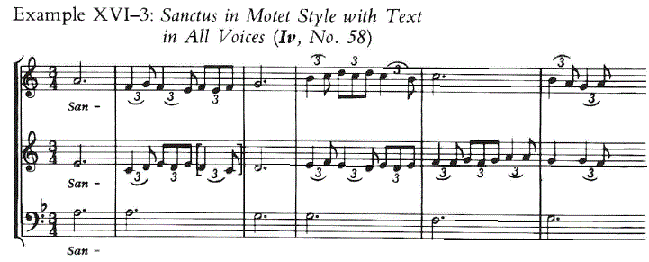
�ᐺ���╡���̐��������҂��ꂽ�l���Ƃ͈قȂ��Ă��邱�Ƃ͂悭����B�����āA���y����y���Ƃ��������悭�N����B�������������܂����́A���̉��y�\���ɂ��ւ�炸�A�~�T�Ȋe�y�͂����܂��܂Ȋ�y��y�̑g�ݍ��킹�ʼn��t���ꂽ��A���y�݂̂ʼn��t���ꂽ�肷��\�����������Ă���B
���̂悤�ɉ��t���ω����邱�Ƃ́A�قȂ����e�L�X�g�z�u�����قȂ����ʖ{���ł͂قƂ�Ǐؖ�����Ȃ��B�����Ƃ��悭�m��ꂽ��́A�A�v�g�ʖ{���܂ނR�̎������Ɍ�����N���h�ƁA�R�����������ɓ����l���̃g�D���l�[�~�T�ł���B��S�̎ʖ{�̓g�b�v�����݂̂Ƀe�L�X�g�����������y���������Ă���B���̔ł̓\���O�X�^�C���ł��邪�A���炩�ɁA�S�ʖ{���ł͈�ԌÂ��B���Ƃ����āA�K�������A�����Ƃ��I���W�i���Ȍ`�������Ă���킯�ł͂Ȃ����B���������P�[�X�ł́A�ǂ̔ł��ŏ��ł��邩�͌��߂������B�������T���āA���y�\���̓����́A�e�L�X�g�̔z�u�����A��ȉƂ����̂��Ƃ��Ƃ̈ӌ��ɏ]���B
p385
MASS CYCLES
������14���I�̃~�T�̊y�͓͂Ɨ�������i�ŁA�ʏ핶�̊��S�ȃ|���t�H�j�[�ݒ�Ƃ��č�Ȃ��ꂽ�؋��͂Ȃ��B�C�����A�A�A�v�g�ʖ{�́A���҂Ƃ��A���B�j�����̉��y�̂�p�[�g���[�̑傫�Ȃ��̂ł��邪�A���������z��Ɋւ��ẮA���Ȃ�s�������������ł���B�������A�����e�L�X�g�̐ݒ�ł̓O���[�v�������X���ɂ���B
�ǂ̎ʖ{���A�~�T�S�̂��\�����郆�j�b�g�Ƃ��Ă̂T�̊y�͂͑��݂��Ă��Ȃ��B�C�����A�ʖ{�ł́AAgnus
Dei�������Ă���B�������͂��łɁA�}�V���[�̃m�[�g���_���~�T���A14���I�ɂ�����ЂƂ�̍�ȉƂɂ�銮�S�ȃ~�T�Ȃ̗B��̗�ł��邱�Ƃ��L�q�����B�������A���̎����̂S�̂ق��̃~�T�Ȃ́A�ʏ핶�S�̂̃|���t�H�j�[�I���s�́A�������Ɏ��ۓI�ȂȂ��ƂɂȂ��Ă��Ă������Ƃ������Ă���B
�����S�̃~�T�Ȃ́A�����ɂ����ẮA�g�D���l�[�A�g�D�[���[�Y�o���Z���i�A�\���{���k�̎ʖ{�Ƃ��Ēm���Ă���B�Ō�̖��O�i�\���{���k�j�́A�ȑO�́A�x�T���\���̃~�T�Ȃƌ����Ă����B��̍�Ƃ����́A���̋N����_���A���̂ق��̂R�̃~�T�Ȃƈ�v����悤�ɁA�\���{���k�̃~�T�Ƃ��Ă����B���݂̎ʖ{�̂���ʒu�́A�K�������A���̏ꏊ�������Ă��Ȃ��B
�S�̃~�T�Ȃ̊��������ł��낤�ƁA�����͂��ׂāA�C�����A�A�A�v�g�ʖ{�ɕۑ�����Ă���A���B�j�����̃��p�[�g���[�ւ̊֘A���ؖ����Ă���B�ɂ�������炸�A�����S�͂��ׂāA�����̓_�ɂ����āA�قȂ��Ă���B���ꂼ��̃~�T�Ȃ̊T���͂���䂦�A14���I�̓T��I�|���t�H�j�[�̕`�ʂ����邱�ƂɂȂ�ł��낤�B
THE�@MASS OF TOURNAI
�y����
�g�D���l�[�̑吹���ɂ���ʖ{�́A�|���t�H�j�[�~�T�Ȃ̂����Ƃ��Â����̂ł���ƍl�����Ă���B����́A�ʏ핶�̂T�̊y�͂��琬��A�Ō��Ite�A missa est�̃��e�b�g�����Ă���BSanctus��Kyrie�͌�ɏ�����Ă���B�ǂ̊y�͂��A���Ƃ��Ƃ̃~�T�Ƃ̊֘A�͂Ȃ��BKyrie
�́A�����I�l����3�����̂��̂ł��邪�ASanctus �́A�R����"in excelsis"�������A���m�t�H�j�[�ł���B�g�D���l�[�̎ʖ{�̎c��́A�v���C���`�����g���p�[�g���[�̈ꕔ�ł���B�����̃Z�N�V�����́A�f�ГI�ł���|���t�H�j�[�~�T�Ƃ݂͌��ɖ��W�ł���B
386
�@The nature of this odd collection of music makes it clear that the Mass
of Tournai was copied as a unit to provide a completely polyphonic performance
of the Ordinary. It is equally clear, however, that the Mass was not composed
as a unit. The Kyrie, Sanctus, and Agnus Dei use Franconioan notation of
longs and breves in note -against-note counterpoint with modal rhythms
that suggest a possible origin in the latter part of the thirteenth century
(Example XVI-4).
�@���̒��r���[�ȉ��y�R���N�V�����̐����́A�g�D���l�[�~�T���A�ʏ핶�̊��S�ȃ|���t�H�j�[���H�����邽�߂̃��j�b�g�Ƃ��Ďʕ����ꂽ���Ƃ𖾂炩�ɂ��Ă���B�����������ɁA�~�T�̓��j�b�g�Ƃ��č���Ă��Ȃ��������Ƃ��m���ł���BKyrie, Sanctus, and Agnus Dei �́A�t�����R�h�̋L���@��longs��breves��p���A ���[�h���Y���ŁAnote -against-note�I�ɏ�����Ă���A13���I�Ō�̋N���ł���\���������Ă���(Example XVI-4)�B
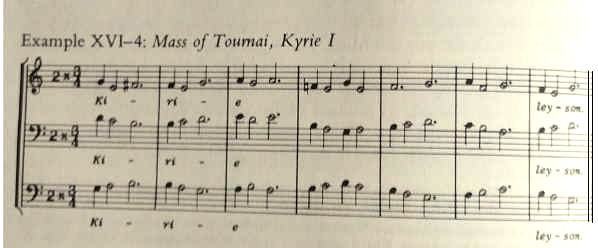
(Example XVI-4)
Freer rhythms and the notational innovations of the Ars Nova characterize
the other three move -ments, particularly the Gloria (Example XVI-5). This
movement applies the principles of Philippe de Vitry in ways that would
have been impossible before the second quarter of the fourteenth century.
Even for this period the Gloria seems unusually advanced in its occasional
use of parallel triads in first inversion to approach a cadence (Example
XVI-5b). Only at a somewhat later time do such progressions become frequent,
and they are still likely to be regarded as a distinctive trait when they
appear in fifteenth-century music.
Ars Nova�̂�莩�R�ȃ��Y���ƋL���@�̊v�V�́A�~�T�̂��̑��̂R�̊y�́A����Gloria������Â��Ă���B���̊y�͂́A14���I�̑�Q�l�����I�ȑO�ɂ͕s�\�ł���Philippe
de Vitry�̌�����K�p���Ă���B���̊��Ԃɂ����Ă����AGloria�̓J�f���c�ւ̃A�v���[�`�ɑ��A���s �i��P�]��`�j�����ʂɎg���Ă���悤�Ɍ����� (Example XVI-5b)�B�ق�̂��Ƃ̎���ł́A���������i�s�͕p�ɂɂȂ�A15���I�̉��y�Ɍ��������I�Ȍ`���ƂȂ�B �i��P�]��`�j�����ʂɎg���Ă���悤�Ɍ����� (Example XVI-5b)�B�ق�̂��Ƃ̎���ł́A���������i�s�͕p�ɂɂȂ�A15���I�̉��y�Ɍ��������I�Ȍ`���ƂȂ�B
(Example XVI-5)
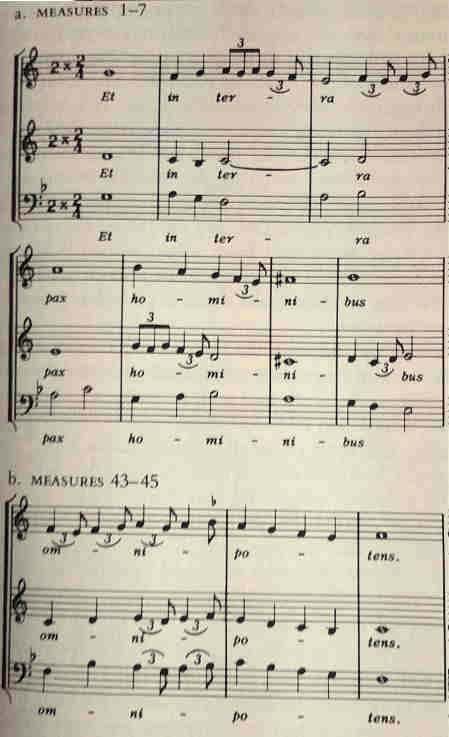
To judge from their divergent styles, then, the movements of the Tournai
Mass may have been composed over a time span of nearly fifty years. Further
evidence that the Mass was not composed as a unit comes from the presence
of two of its movements in other manuscripts. The Credo must have been
widely known, for�\as noted above �\it is found in three other sources
including the Avignon repertory preserved in Apt. Similarly, the related repertory of the Ivrea Codex includes the motet
on Ite, missa est. All of this evidence marks the Mass of Tournai as a compilation of�@independent
movements that were brought together to permit polyphonic per -formance
of the complete Ordinary.
�����������l�I�ȗl�����画�f���āATournai Mass�̊e�y�͂�50�N�߂��X�p���ł����č�Ȃ��ꂽ���̂Ǝv����B�~�T�Ȃ����j�b�g�Ƃ��č�Ȃ��ꂽ���̂ł͂Ȃ��Ƃ����X�Ȃ�؋��́A���̑��̎ʖ{���̂Q�̊y�͂̑��݂�������Ă���B�����Apt�ʖ{���ɕۑ�����Ă���Avignon�̃��p�[�g���[���܂�3�̑��̎����Ō��o�������B���l�ɁA�C�����A�ʖ{�Ɋ֘A�������p�[�g���[�́A Ite, missa est�ɂ��Ẵ��e�b�g���܂�ł���B���������؋��́AMass of Tournai���A���S�Ȓʏ핶�̃|���t�H�j�[�I���H��������悤�ȓƗ������y�͂̕����̂Ƃ��Ĉʒu�Â���B
By his choice of movements, however, the compiler of the Mass did achieve
a degree of artistic and stylistic unity. All of the movements are for
three voices, and all but the final motet are in simultaneous style. This
unity remains superficial, nevertheless, and scarcely blunts the sharp
contrasts of musical style that are illustrated by the Kyrie and Gloria
excerpts in Examples XVI-4 and 5. The Mass as a whole thus provides another
demonstration that the same method of performance may be used with widely
differing mussical structures.
�������y�͂̑I���ɂ���āA�~�T�Ȃ̕Ҏ[�҂́A�|�p�I�l���I����𐬂������Ă���B���ׂĂ̊y�͂͂R���ł���A�Ō�̃��e�b�g�������āA�����I�l���ł���B�ɂ�������炸�A������������͕\�ʏ�ł���AExamples XVI-4 and 5�̂悤�ɁAKyrie and Gloria�Ŏ����ꂽ���y�I�l���̉s���ΏƂ͂قƂ�ǂ����܂��Ȃ܂܂ł���B
THE MASS
OF TOULOUSE
The Mass of Toulouse has been preserved in a strange way that leaves some
doubt as to whether it was intended to be a complete polyphonic setting
of the Ordinary. The municipal library of Toulouse now owns a large manuscript
devoted entirely to the texts and plainchants of the Mass. This missal
dates from the first half of the fourteenth century but much later- probably
around 1400-someone enterd the polyphonic movements that constitute the
Mass of Toulouse.
The Mass of Toulouse�́A���ꂪ�ʏ핶�̊��S�ȃ|���t�H�j�[�ݒ�ł��邱�Ƃ��Ӑ}����Ă������ǂ����ɋ^��̂���Ƃ����A��ȕ��@�ɂ����ĕۑ�����Ă���BToulouse�̒��̐}���ق͌��݁A�~�T�̃e�L�X�g��v���C���`�����g�S�̂��܂ޑ�K�͂Ȏʖ{��ۗL���Ă���B���̋F�����̓��t��14���I�O���ł��邪�A����ɁA�����炭��1400�N����ɁAMass
of Toulouse���\������|���t�H�j�[�y�͂��lj����ꂽ�B
These movements were copied in empty spaces throughout the manuscript,
and only Sanctus and Agnus Dei appear together. After the latter movement,
the scribe noted where the "motetus super Ite missa est" could be found and thus suggested that he was copying a complete Mass.
���������y�͂́A�ʖ{�S�̂̋����Ɏʕ����ꂽ�BSanctus and Agnus Dei �͈ꏏ�Ɍ����BAgnus
Dei �̌�ł́A���L��"Ite missa est���motetus"������ꏊ���L�q���A���S�ȃ~�T�Ȃ��ʕ��������Ƃ������Ă���i���}�j�B

http://imslp.nl/imglnks/usimg/6/69/IMSLP380958-PMLP615341-tolouse_missa.pdf
���Q�Q�W���
There is no trace of a Gloria, however, and all that exists of a Credo
is the tenor part from Crucifixus to the end. This fragment is sufficient to establish its identity with
a widely known Credo that appears in both Iv and Apt as an dependent movement and that also forms part of the Barcelona Mass.
Gloria�͂Ȃ����ACredo�̑��݂̂��ׂẮACrucifixus����Ō�܂ł̃e�m�[���p�[�g�ł���B���̒f�Ђ́A�Ɨ������y�͂Ƃ��ăC�����A�ʖ{�ƃA�v�g�ʖ{�̑o���Ɍ���ABarcelona Mass�̈ꕔ���`������Credo�Ƃ��Ēm���Ă��铯�ꐫ���m������ɂ͏\���ł���B
The only other movement of the Toulouse Mass that might establish a connection with the repertory of Avignon is the Agnus Dei, which also appears in a fragmentary manuscript now in
the archives of the cathedral of Gerana in northeastem Spain. Of the three
other Mass movements in the framgent, a Kyrie and a Kyrie trope are also
found in Iv and Apt respectively.
�A���B�j�����̃��p�[�g���[�Ɗ֘A��������Toulouse Mass�̗B��̂��̑��̊y�͂́AAgnus
Dei�ł���B����́A�k�X�y�C����Gerana�吹���̌Õ������̒f�ГI�ʖ{���Ɍ�����B
�~�T�̂��̑��̂R�̊y�͂̂����Akyrie��Kyrie�̃g���[�v�X���܂�Iv and Apt�̂��ꂼ��Ɍ������Ă���B
As it stands, then, the Mass of Toulouse consists of four movements--Kyne Sanctus, Agnus Dei, and a motet on Ite,missa est plus a Credo that can be completed from other sources. Why the scribe failed to complete the Credo himself or to provide a Gloria remains unknown. Perhaps the Mass, like some in plainchant, never included these two movements.
�����_�ɂ����ẮAMass of Toulouse�́A4�̊y�́AKyne�A Sanctus�AAgnus Dei�AIte,missa est�̃��e�b�g�A���̎����Ŋ�������Ă���Credo����\������Ă���B �Ȃ��M�L�҂��N���h���g�����������邱�Ƃ��ł��Ȃ������̂��A�O�����A���m���邱�Ƃ��Ȃ��c���ꂽ�̂��B
�����炭�A�~�T�Ȃ��A�v���C���`�����g�̂������̂悤�ɂ悤�ɁA������2�̊y�͂������Ċ܂�ł��Ȃ������̂ł��낤�B
�@Despite differences in age and style, the Tournai and Toulouse Masses resemble each other in two important ways. Both are compilations of musically independent movements, and each is unified to some extent by having the same disposition of voices in all movements. The Tournai use Mass, however in song rather than simultaneous style. This is true of the incomplete Credo and even of the misnamed "motet on lte musa est, which has only one voice with text above textless tenor and contratenor
parts.
�@����Ɨl���̈Ⴂ�ɂ�������炸�ATournai and Toulouse Masses�ɂ͂Q�̏d�v�ȓ_�ŁA���ʂ��Ă���B����i�Ƃ��A���y�I�ɓƗ������y�͂���Ȃ��Ă��邱�ƁA�����Ă��ꂼ�ꂪ���ׂĂ̊y�͂ɂ����āA�����̓����z�u�����āA������x�̓��ꐫ��ۂ��Ă��邱�ƁA�ł���B����͕s���S�ȃN���h�ɂ����Ă��Alte missa est�̃��e�b�g�i1�����̂݃e�L�X�g������A�e�m�[���ƃR���g���e�m�[���ɂ͉̎����Ȃ��j�ɂ����Ă��^���ł���B
The designation probably reflects the tradition of such motets and the
fact that the one text�\Laudemus Jesum Christum (Let us praise Jesus Christ)�\ends with the word "gratias" and may be regarded as a trope. One wonders whether the scribe or compiler of the Mass simply ignored the musical structure or whether he omitted the triplum of a four-voice motet to bring the piece into stylistic agreement with the other movements.
�ilte missa est�́j�����w���͂����炭�A���̂悤�ȃ��e�b�g�̓`���ƁA��̃e�L�X�gLaudemus Jesum Christum�i�C�G�X�E�L���X�g���^�����悤�j�Ƃ������t��"gratias"�Ƃ������t�ŏI����Ă���Ƃ��������f���Ă���Ǝv����B�����āA�g���[�v�X�Ƃ��Č��Ȃ���Ă����� ��������Ȃ��B�~�T�Ȃ̕M�L�҂�Ҏ[�҂��P�ɉ��y�̍\���������̂��A����Ƃ�4���̃��e�b�g��triplum���ȗ����đ��̊y�͂Ƃ̗l���ɍ��킹���̂��͂͂����肵�Ȃ��B

http://imslp.nl/imglnks/usimg/6/69/IMSLP380958-PMLP615341-tolouse_missa.pdf
p�P�S�X���
The Sanctus of the Mass also suggests the possibility of such an adaptation.
Its contratenor lies in the same range as the cantus, and both voices use
the same rhythmic and melodic figures above a tenor in longer note values
(Example XVI-6 �j�BOnly the absence of text in the contratenor prevents
classification of this movement as three-voice motet style." In the
other movements, the contratenor kies in a lower range than the cantus
and is somewhat less active rhythmically, although the two parts often
engage in hocket patterns. Whatever the original form of the Sanctus may
have been, it again illustrates the difficulty of classifying highly melismatic
styles.
�~�T��Sanctus�́A���������K�p�̉\�����������Ă���B�R���g���e�m�[����cantus�Ɠ�������ł���A�������́A�e�m�[����̂�蒷�������̓������Y���ƃ����f�B��p���Ă���(Example
XVI-6 �j�B�R���g���e�m�[���ɂ�����e�L�X�g�̌����́A���̊y�͂̕��ނ��R�����e�b�g�l���Ƃ��Ă͔ے肵�Ă���B�ق��̊y�͂ɂ����ẮA�R���g���e�m�[���́Acantus�����Ⴂ����̌��ƂȂ�B�����āA�����ԂY���I�ɂ͕s�����ƂȂ�B�Q���͂����z�P�b�g�p�^�[�����`������̂ł��邪�BSanctus�̂��Ƃ��Ƃ̌`�����ǂ�����A����́A���x�ȃ����X�}�l���̕��ނ̍����������Ă���B

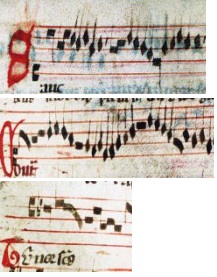
http://imslp.nl/imglnks/usimg/6/69/IMSLP380958-PMLP615341-tolouse_missa.pdf
p�Q�Q�V���
p390
In the Agnus Dei with the trope Rex immense pietatis , a syllabic setting of the text in short note values clearly differentiates
the cantus from the lower parts.Here,song style is unmistakable,as it is
in the final "motet" and the Credo.
�g���[�v�XRex immense pietatis��Agnus Dei�ɂ����āA�Z�������̃e�L�X�g�̃V���u���ݒ�́A���̐�����cantus����͂�����Ƌ�ʂ��Ă���B�����ł́Asong
style�́A�ԈႢ�Ȃ��A�Ō�́h���e�b�g�h��N���h�̂悤�ɂȂ��Ă���B
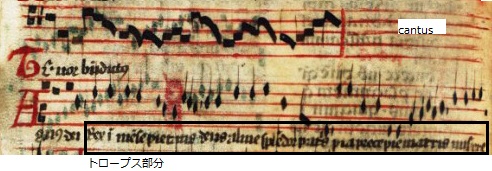
THE MASS OF BARCELONA
http://www.lib.latrobe.edu.au/MMDB/Mss/BARCC.htm
�ʖ{��
The Mass of Barcelona�́ATournai and Toulouse Masses�Ƃ́A�������̏d�v�ȓ_�ňقȂ��Ă���B��P�ɂ����āA�����̓v���C���`�����g�Ƃ̊֘A���Ȃ��B���̑���ɁABarcelona�@Mass�̂T�̊y�͂́Alte missa est�ɂ�����motet�����݂��Ă��炸�A�Q�̃��e����̃��e�b�g�ƂQ�̂��̑��̃~�T�̊y�́i�����̓g���[�v�X�����ꂽKyrie��Gloria�ł���j�ɂ���Ċ�������Ă��鏬���Ȏʖ{�̍ŏ��ɘA�����Č���Ă���B12folio�̑����Ə������̎��́A���̎ʖ{���A14���I����̑�K�͂ŏd�v�ȃR���N�V�����̍ŏ��̕����ɉ߂��Ȃ��Ƃ������Ƃ𐄒肳���Ă���B�������A�����ɂ��������̂́ATournai
and Toulouse Masses�ȏ��Avinion�ɂɖ��ڂɊW���Ă��邱�Ƃ��\���Ɏ����Ă���B
�@Tournai and Toulouse Masses�̕Ҏ[�҂����́A�����̈�ʓI�z����������y�͂�I�����邱�Ƃɂ���āA����̎ړx�������Ă����BTournai�̃~�T�Ȃɂ����Ă͂R���̓����l���AToulouse�̃~�T�Ȃɂ����Ă͂R����song
�l���A�Ƃ������ɁBBarcelona�@Mass�ɂ����ẮA�܂������قȂ����������A�y�͂̑I�������肵�Ă���悤�Ɍ�����B������{�I�ȗl���̑���ɁA�~�T�̂T���̂��ꂼ��́A�قȂ����z������Ă���B
p390
For the most parts,three voices move together in rhythms that are similar
when not identical. A somewhat more independent contratenor in the Christe adds variety to the texture, as does the imitative use of a three-note
figure in Kyrie ll.
Kyrie �́A���y�\���Ɖ��t�̌��܂��������̊ԂŖ��炩�ȑΉ����Z�������l���ł���B�قƂ�Ǒ啔���A�R���̓��Y���I�Ɉꏏ�ɓ����Ă���BChriste eleison�ɂ����邢���Ԃ�Ɨ������R���g���e�m�[���́AKyrie ll�̂R�����̖͕�I�g�p�̂悤�ɁA�����ɕω��������Ă���B�B

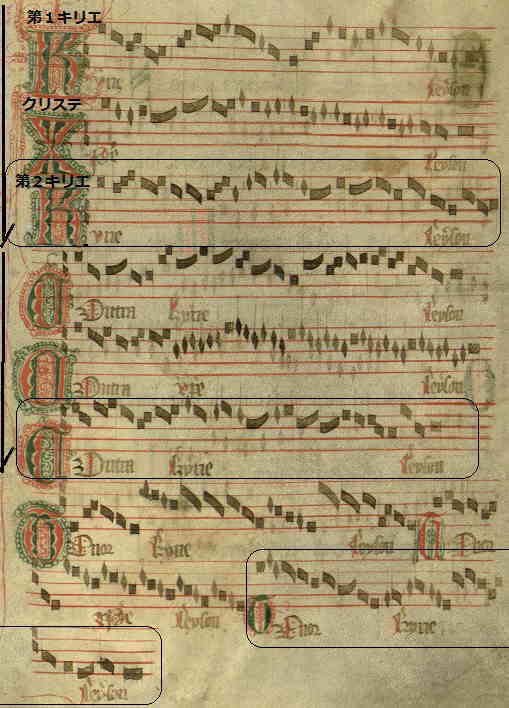
�ʖ{��肐�P
�@In the Apt manuscript, the Gloria and Credo are both in song style and
each has tenor and contratenor parts that are rhythmically similar and
lie in the same range beneath the cantus. As it appears in the Barcelona
Mass, however, the Gloria has a different contratenor, which lies in the
same range and uses some of the same rhythms as the cantus. The musical
structure thus resembles a three-voice motet or a secular song with a textless
triplum instead of a contratenor (see Chapter17 ).
�@�A�v�g�ʖ{�ɂ����ẮAGloria and Credo �͂Ƃ���song �l���ł���B�����Ă��ꂼ��́Acantus�̉����ŁA���Y���I�ɓ����̃e�m�[���ƃR���g���e�m�[���������Ă���B������Barcelona Mass�Ō�����悤�ɁAGloria�͕ʂ̃R���g���e�m�[���������Ă���B����͓��������ł���Acantus�Ɠ������Y�������悤���Ă���B�䂦�ɁA���y�I�\���́A3�����e�b�g���邢�́A�R���g���e�m�[���̑���Ƀe�L�X�g�̂Ȃ�triplum���������̂Ɏ��Ă���B
Whether or not this modification resulted from a deliberate effort to enhance
the stylistic contrasts o�� the Barcelona Mass, it does distinguish the
Gloria from the more usual song style that is retained in the Credo.
�ό`�� Barcelona Mass�̗l���I�ΏƐ������߂悤�Ən�l���ꂽ���ʂ��ۂ��́ACredo�ɕێ����ꂽ�ʏ�̃\���O�l������Gloria����ʂ��邱�Ƃɂ���B
In quite differnt ways, the Sanctus and Agnus Dei form a second pair of
movements that are stylistically related, yet clearly distinguished from
one another. With its two paraphrase-tropes, the Sanctus appears at first
glance to be a normal motet in which all three voices are quite strictly
isorhythmic throughout six staements of a nineteen-measure talea.
�܂������قȂ��������ŁASanctus and Agnus Dei �́A�l���I�ɊW�̂���y�͂̑�Q�̃y�A���`������B���������炩�Ɍ݂��ɋ�ʂ���Ă���B�Q�̃p���t���[�Y�g���[�v�X�ƂƂ��ɁA
Sanctus �͈ꌩ���āA���ׂĂ̂R�����������ɃC�\���Y���ł���i19���߂̃^���A�̂U��statements)�ʏ�̂̃��e�b�g�ł��邱�Ƃ͖��炩�ł���B
A closer look at the structure reveals that what seems to be the motetus
is actually the tenor part. It is the lowest of the three voices, and with
the cantus forms framework for the composition. The textless third part
completes that framework when the tenor or cantus rest,but at other times
it funcitions as a contratenor and justifies its being so named in the
manuscript. In form, but the distribution of vocal and instrumental parts
is one that first appears in Italian secular songs of the later fourteenth
century (see Chapter 18).
�\���̏ڍׂ�����ƁAmotetus�̂悤�Ɍ�����̂́A���ۂɂ̓e�m�[���p�[�g�ł���B����́A�R���̂����ŁA�Œᐺ���ł���Acantus�͍�i�̃t���[�����[�N���`�����Ă���B�e�L�X�g�̂Ȃ���R�����́A�e�m�[�����邢��cantus���x���ɂȂ�ƁA�t���[�����[�N�����������邪�A�����łȂ��ꍇ�ɂ́A����̓R���g���e�m�[���Ƃ��ċ@�\���A�ʖ{�ɂ����Ė��Â���ꂽ�悤�ɐU�����B�������A�`���ɂ����ẮA���y�Ɗ�y�p�[�g�̔z���́A14���I�̌㔼�̃C�^���A�̐�����i�ōŏ��ɏo������B
p391
A similar distribution occurs in the Agnus Dei, where the tenor and cantus
are again the two voices that have the text. Now, however, there are two
textless contratenors a higher that lies in the range of the cantus and
a lower in the range of the tenor. The resulting texture differs from a
normal four-voice motet not only in having a vocal tenor and cantus, but
also in the rhythmic similarity of all four parts.
�����悤�Ȕz���́AAgnus Dei�ɂ����Ă��o������B�����ł́A�e�m�[����cantus�̓e�L�X�g�����Q�����ƂȂ��Ă���B�������A�����ł́Acantus�͈̔͂��������͈͂ŁA�e�m�[���͈̔͂����Ⴂ�Q�̃e�L�X�g�̂Ȃ��R���g���e�m�[��������B���̌��ʂ̓e�m�[����cantus���������ł͂Ȃ��A�S�̂��ׂĂ̐��������Y���I���ꐫ�����A�ʏ�̂S���̃��e�b�g�Ƃ͈قȂ锧���ƂȂ�B
Every part, moreover, is essential to the musical structure and none could
be omitted without damage to the harmonic and rhythmic organization. The
increased sonority of four-part polyphony in the Agnus Dei does more than
provide a fitting climax for the Barcelona Mass. By its style and structure,
that polyphony foreshadows fifteenth- century developments, including the
emergence of an international musical style that will be discussed in the
final chapters of this book.
����ɂ��ꂼ��̐����́A���y�I�\���̖{���ł���A�a����Y���̍\�������ƂȂ��ȗ����ꂽ��͂ł��Ȃ��BAgnus
Dei�ɂ����鑝�傷��4���̋����́ABarcelona Mass�ɂƂ��ẴN���C�}�b�N�X�ƂȂ�B���̗l���ƍ\���Ƃɂ���āA�|���t�H�j�[�́A15���I�̔��W��\�����A���ۓI�ȉ��y�l���̏o�����܂ނ��ƂɂȂ�B
The entire Mass, indeed, might have been designed as a survey of musical
style from simultaneous, through secular song, to the newest hybrid styles
of the closing fourteenth century. It is this aspect of the Barcelona�@Mass
that makes it both the most unusual and most interesting of the early Mass
compilations.
�~�T�ȑS�̂́A�����I�l������A������i��ʂ��āA14���I���̍ŐV�̍����l���ւ̉��y�l���̒����Ƃ��Ă̖������ʂ����Ă���B����́ABarcelona�@Mass
�������̃~�T�Ȃ̕Ҏ[�̂����Ƃ���}�ŋ����[���ϓ_�ł���Ƃ�����B
MUSICALLY RELATED MASS MOVEMENTS AND THE SORBONNE MASS
Most fourteenth-century Mass movements appear to have been composed as
independent pieces with no thought of establishing musical relationships
among the various parts of the Ordinary. Indeed, the stylistic contrasts
in the movements brought together to form the Barcelona Mass stand in direct
opposition to the concept of a musically unified Mass cycle. Even the superficial
unity of the Tournai and Toulouse Mass compilations probably reflects no
higher artistic consideration than desire -or need-to maintain one method
of performance throughout the service.
�啔����14���I�̃~�T�Ȃ̊y�͂́A�ʏ핶�̂��܂��܂ȕ����̉��y�I�W�ɂ͂��܂�W�Ȃ��A�Ɨ�������i�Ƃ��č�Ȃ���Ă����B�������A�y�͂ɂ�����l���̑ΏƐ��́ABarcelona
Mass���A���y�I�ɓ��ꂳ�ꂽ�~�T�T�C�N���̊T�O�Ƃ͑Η��̕����ɒǂ�����ł����BTournai
and Toulouse Mass�̕\�ʓI�ȓ��ꐫ�ł����A�����炭�́A��q��ʂ��Ă̎��H�̕��@���ێ�����ȏ�ɍ��x�Ȍ|�p�I�l�@�f�͂��Ă͂��Ȃ��B
�@In the Sorbonne Mass, however, the Agnus Dei quotes sections from both
the Kyrie and the Sanctus and thus gives evidence of an attempt to create
some measure of unity in the Mass as a whole. This is by no means the only
peculiarity of the Sorbonne Mass. On the basis of a "signature in
the middle of the Kyrie," the entire Mass has been attributed to one
Johannes Lambuleti. Whether Lambuleti was responsible for the composition or compilation all the movements, or even of the Kyrie,
remains somewhat doubtful. If the Mass is indeed his work Lambuleti, following
Machaut, would become the second fourteenth-century composer to write what
was probably a complete polyphonic setting of the Mass Ordinary.�@
�@������Sorbonne Mass�ɂ����ẮAAgnus Dei ��Kyrie and the Sanctus�̗�������̈��p�ł���B�䂦�ɁA�T���āA�~�T�ɂ����铝�ꐫ�̎ړx�����グ�鎎�݂̏؋���^���Ă���B����͉����ASorbonne Mass�ɓƎ��̂��̂ł͂Ȃ��B"signature in the middle of the Kyrie,"�����ɂ��ĂƂ��āA�~�T�S�̂���l�̒j�AJohannes Lambuleti�ɋA�����Ă���̂ł���BLambuleti���y�͑S�̂̍�Ȃɂ���������̂��ǂ����AKyrie�����Ȃ̂��A�͊����^�₪�c���Ă���B�~�T�����ׂĔނ̍�Ȃɂ����̂ł���A�}�V���[�ɂ��ŁA�~�T�ʏ핶�̊��S�ȃ|���t�H�j�[�ݒ���s�������14���I�̍�ȉƂƂ������ƂɂȂ�ł��낤�B
�@
As it now stands, the Sorbonne Mass lacks Credo but ends with a fifth
movement in the form of a two-voice Benedicamun Domino.With possibly this one exception, every movement is incomplete to some
extent ,but enough has been preserved to establish that they all draw
some part of their musical material from other sources, primarily the
older Avignon repertory of the Ivrea Codex. Such borrowings from preexistent
polyphony are not without precedent, and in a few other instances the same
or similar material appears in different Mass movements. We may use the
Sorbonne Mass, however, to illustrate some of the ways in which composers
used borrowed material to create related but different Mass movements.
�@���݂ɂ����ẮASorbonne Mass��Credo�������Ă��邪�A2����Benedicamun Domino�̌`��5�Ԗڂ̊y�͂ŏI����Ă���B���̗�O�������āA���ꂼ��̊y�͂͊����s���S�ł��邪�A���̎�������̉��y�f�ނ���̈��p�A��{�I�ɂ̓C�����A�ʖ{���̌Â�avignon���p�[�g���[�ŁA���e���m�����邱�Ƃ͏\���ɉ\�ł���B�������������̃|���t�H�j�[����̎ؗp�͐�Ⴊ�Ȃ��킯�ł͂Ȃ��A���̑��̂������̗�ɂ����āA���l�̑f�ނ��قȂ����~�T�̊y�͒��ɏo�������B�����������́A��ȉƂ��ؗp�����������g�p���Ċ֘A����قȂ�~�T�Ȃ̊y�͂��쐬������@�̂�������������邽�߂�Sorbonne
Mass���g�����Ƃ��ł��悤�B
For the Sorbonne Kyrie in motet style, Lambuleti took the tenor of a two-voice
Kyrie in Iv and added two upper voices, neither of which resembles the cantus of his source. Both Kyries are tropes, but with different texts and a curious discrepancy of position. The Ivrea Kyrie is sung to the first three stanzas of the trope Sol justicie and is therefore Kyrie I. (The Christe and Kyries ll and III are either missing or illegible in the three versions copied in Iv.) The text of the Sorbonne Kyrie, on e other hand, is the ninth stanza
of a widely known trope, Kyrie Rex senitor. It seems probable, therefore, that the Sorbonne Mass originally began
with a much more extended Kyrie in four sections-Kyrie l ,Christe, Kyrie
ll, and Kyrie Ill-of which only the last survives.
Sorbonne��Kyrie�̓��e�b�g�l���ł��邽�߂ɁALambuleti�́A�C�����A�ʖ{���̂Q����Kyrie�̃e�m�[�������グ�A����ɂQ���̏㐺�����������B����͑f�ނƂ͎��Ă������ʂ��̂ƂȂ����B������Kyries�̓g���[�v�X�������Ă��邪�A�e�L�X�g�͈قȂ��Ă���A���̈ʒu�ɂ������[���s��v������B�C�����A�ʖ{��Kyrie�ł́A�g���[�v�XSol justicie�̍ŏ��R�̃X�^���U���̂��A����䂦���ꂪKyrie I�ł���iChriste, Kyrie ll, Kyrie Ill�͕����A���邢�̓C�����A�ʖ{���̂R�̔łɂ����Ĕ��Ǖs�\�j�B����ASorbonne�� Kyrie�̃e�L�X�g�́A�L���m��ꂽ�g���[�v�XKyrie Rex senitor�̑�X�X�^���U�ł���B����䂦�����炭�A Sorbonne Mass �͂��Ƃ��Ƃ́AKyrie
l ,Christe, Kyrie ll, Kyrie Ill�̂S����́A���g�����ꂽKyrie �Ŏn�܂��Ă����\��������B
The Gloria in simultaneous style is also for three voices and is incomplete
at the end rather than at the beginning. All of the upper voice has been
preserved (132 measures), but the tenor is missing after measure 29 and
the middle voice after measure 55. This movement opens with an almost exact
quotation of the first two measures of a Credo in Iv(Example XVI-8). Thereafter, the two movements go their separate ways,
and the claim that one is a "parody" of the other rests on a
few and scattered similarities that might be found in any two movements
written in the same mensuration and mode.
�@Gloria�͓����l���ł��邪�A�R���̂��̂ł���A�Ō�̂ق����s���S�ł���B�㐺���̂��ׂĂ͕ۑ�����Ă��邪�A�e�m�[����measure
29�ȍ~��measure 55�̌�̒��Ԑ����������ƂȂ��Ă���B���̊y�͂́A�C�����A�ʖ{����Credo�̍ŏ��̂Q�̕����̐��m�Ȉ��p�ł���B���̌�Q�̊y�͕͂ʁX�ɂȂ�A�Е��͂����Е��̃p���f�B�ł���A�����v�ʖ@��[�h�ŏ����ꂽ�Q�̊y�͒��ɂ݂���T���U�炳�ꂽ�������ł��邱�Ƃ�������B
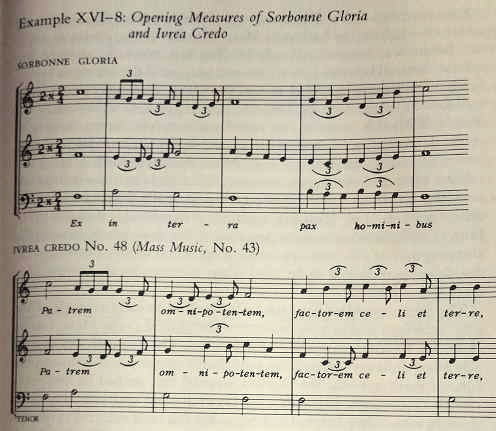
The correspondence between the opening measures of the Sorbonne Gloria
and the Ivrea Credo must have been deliberate, but it is the only link
between the two movements that can be established with any certainty. That
link makes it probable, nevertheless, that the Sorbonne Mass once included
the lvrea Credo.
�@Sorbonne Gloria and the Ivrea Credo�̍ŏ��̕����̑������́A�n�l����˂Ȃ�Ȃ����A���y�͂̃����N�͊m�M�������Ċm�����ꂽ���̂ł���B�ɂ�������炸�A�������������N�́ASorbonne
Mass�����Ă̓C�����A�ʖ{����Credo���܂�ł����\������������B
p392
Despite the fragmentary state of the Sorbonne Sanctus, it clearly derives
from an Ivrea Sanctus, which, in turn, is a reworking of an Agnus Dei in
a manuscript now in the municipal library of Cambrai. The relationships
of the three movements are again complex, but the order of their composition
is unmistakable. In the Sorbonne Sanctus literal quotations from the Ivrea
Sanctus include parts of an introduction that this intermediate movement
added to the Cambrai Agnus Dei. Interspersed among these quotations we
find other, more or less varied excerpts from the Ivrea Sanctus and a few
passages that appear to be entirely new.
�@Sorbonne ��Sanctus�͒f�Џ�Ԃł��邪�A����͖��炩�ɁA�C�����A�ʖ{����Sanctus�R���ł���B����ɁACambrai
�̎����̐}���قɌ��ݑ��݂��Ă���ʖ{����Agnus Dei ��rework�ł�����B�����R�̊y�͂̊W�͕��G�ł��邪�A��Ȃ̏����͂͂����肵�Ă���BSorbonne
��Sanctus�ɂ����ẮA�C�����A�ʖ{����Sanctus����̕����ʂ�̈��p�́A���Ԋy�͂�Cambrai
��Agnus Dei�������������̕������܂�ł���B�����������p�̍L���肩������́A�C�����A�ʖ{����̕ω��������o�Ƃ܂������V�����Ȃ��������炩�̃p�b�Z�[�W�����o���̂ł���B
�@
Only two voices of the Sorbonne Agnus Dei have been preserved, but in
Agnus 1 they fit perfectly with the single voice of the Sanctus, measures
1-12. Confirming this restoration is the resulting literal quotation of
the first four measures of the lvrea Sanctus. Thus we can be sure that
both the Sanctus and Agnus Dei of the Sorbonne Mass were originally three-voice
compositions and that the surviving parts of the latter movement are the
upper voice and the tenor. The second Agnus is unrelated to any surviving
part of the Sorbonne Mass, but the outer voices of the Kyrie return with
only slight changes in Agnus Ill. It seems probable, therefore, that Agnus
ll also quoted preexistent material, perhaps from an earlier portion of
the Kyrie.
�@Sorbonne�� Agnus Dei�͂Q���������ۑ�����Ă��邪�AAgnus 1�ɂ����ẮASanctus��measures
1-12�����̒P�ꐺ�������S�Ƀt�B�b�g����B���������Z���́A�C�����A�ʖ{��Sanctus�̍ŏ��̂Smeasures�ɂ��Ă̕����ʂ�̈��p�̌��ʂł���B����䂦�ɁA�����́ASanctus
and Agnus Dei of the Sorbonne Mass�̗����́A���Ƃ��Ƃ́A3����i�ł���A��҂̊y�͂̌��������͏㐺���ƃe�m�[���ł��邱�Ƃ��m���߂��Ă���B��QAgnus
��Sorbonne Mass�̌����̐����Ƃ͖��W�ł��邪�AKyrie�̊O���̐����́AAgnus
Ill �̂ق�̋͂��ȕω��ł܂��߂��Ă��Ă���B����䂦�AAgnus ll���܂��A�����̑f�ނ���̈��p�ł���A�����炭�͂���ȑO��Kyrie�̕������炩������Ȃ��B
p394
�@Following the Agnus Dei, two-voice setting of Benediamus Domino seems to conclude the Sorbonne Mass. Whether it was meant to fulfil this
function is somewhat doubtful. The text replaced lte, missa est only when Gloria was not sung, and the setting is stylistically incongruous
with the rest of the Mass.
�@ Agnus Dei�̂��ƂŁABenediamus Domino��2���ݒ�́ASorbonne Mass�̌���̂悤�Ɍ�����B���ꂪ���������i����I�j�j�@�\�������Ă��邩�ǂ����́A�����Ԃ�^�₪����B�e�L�X�g�́AGloria���̂��Ȃ��Ƃ��ɂ̂݁Alte, missa est�ɑ��Ēu����������B�����Ă��̐ݒ�̓~�T�̌�Ƃ��ẮA�l���I�ɕs���R�Ȃ̂ł���B
The upper voice is the wel-known plainchant Benedicamus 2 (LU, p. 124) transposed up a fourth. With this melody, the added voice
moves almost entirely in contorary motion and in strict note- against -
note counterpoint with only two note values,longs and in and breves. More
than two-thirds of the intervals�\ unisons, fifths, and octaves�\and the
rest are either thirds or sixths.In effect, therefore, the Benedicamus Domino differs scarcely at all from free organum as described and illustrated
b�� John of Afrighem some three centuries earlier. It suggests, indeed
than wri counterpoint of this sort - probably improvised more often than
written down-continued to be used when more elaborate compositions were
not available. �@
�㐺���́A�悭�m��ꂽBenedicamus 2 (LU, p. 124)���l�x��Ɉڒ����ꂽ���̂ł���B���̃����f�B�ƂƂ��ɁA������������͂قƂ�ǔ��s�I�ɓ����A�킸���Q�̉����Alongs��breves�ŁA������note-
against - note �l���̑Έʖ@������Ă���B������2/3�ȏ�̓��j�]���A�ܓx�A�I�N�^�[�u�ŁA�c��͎O�x�A�Z�x�A�ł���B����䂦���ہABenedicamus Domino�́A3���I���O��John of Afrighem �ɂ���ċL�q���ꂽ�悤�Ȏ��R�I���K�k���ƂȂ��ς��Ȃ��B�������A���̂悤�ȑΈʖ@�́i�����炭�͏����ꂽ���̂��͑��������������ł��낤���j�A��萸�k�ȍ�i�����ɗ����Ȃ��悤�ȂƂ��ɁA�g��ꑱ�����̂ł���B
�@The Sorbonne Mass has been hailed both as an early example of parody
technique and as a forerunner of the unified cylic Mass. Neither claim
can be accepted without qualification. The sixteenth-century parody Mass
drew on a preexistent polyphonic composition�\motet, chanson, or madrigal�\for
the musical material that unified its five movments. Composers displayed
their ingenuity and craftsmanship by the ways in which they adapted and
expanded this basic material to meet the formal requirements of the different
liturgical texts.
�@ Sorbonne Mass �́A�p���f�B�Z�p�̏�����Ƃ��āA���ꂳ�ꂽ�z�~�T�̐�o�҂Ƃ��āA���ڂ𗁂тĂ����B�ǂ���̂��Ƃ��A�m���ɁA���̎��i���Ȃ����Ƃ͂Ȃ��B16���I�̃p���f�B�~�T�́A�����̃|���t�H�j�[��i�A���e�b�g��V�����\���A�}�h���K���̂悤�ȍ�i����̈��p�ł������B�����������y�f�ނ��T�̊y�͂̓���ɖ��ɗ����Ă����B��ȉƂ����́A�قȂ����T��I�e�L�X�g�̌����ȋ��߂ɉ����āA�����̑f�ނ��̗p���A�g�傷������ł����āA���̓V�˂��������B
The fourteenth- century use of borrowed material seems to have had other
goals. In its simplest form it is but another instance of the common medieval
practice of providing old music with new words. The first and third Agnus
of the Sorbonne Mass, in fact, are no more than contrafacta. More elaborate
rate reworking of borrowed material in the Sorbonne Sanctus does resemble
the later parody techniques to some extent. What was com-mon practice in
the sixteenth century, however, was extremely rare in the forteenth,and
there is no evidence of continuous development or indeed of any historical
connection between the two�D
�ؗp�����f�ނ�14���I�ɂ�����g�p�́A���̑��̖ړI�������Ă���悤�ɂ�������B���̂����Ƃ��P���Ȍ`�ɂ����āA�Â����y�ɐV�������t�����Ƃ��������̋��ʂ̊��s�Ƃ���������̗�ł���B�����ASorbonne
Mass�̑�P�C�RAgnus�́Acontrafacta�ȊO�̉����̂ł��Ȃ��BSorbonne ��Sanctus�ɂ�����ؗp���ꂽ�f�ނ̐��k�ŕp�ɂȃ����[�N�́A���Ȃ�̒��x�A��̃p���f�B�Z�p�Ɏ��Ă���B�������A16���I�̈�ʓI�Ȏ��H�́A14���I�ł͔��ɂ܂�ł���A�Q�̐��I�̊Ԃ̘A���I�Ȕ��W�≽�炩�̗��j�I�֘A�̏؋��́A�����Ȃ��̂ł���B
A consideration of musical unity in the Sorbonne Mass imposes much the
same conclusions. Four of the five movement�\ if we include�@Benedicamus Domino�\draw to some extent from outside sources wholly unrelated to each other.
Sorbonne Mass�ɂ����鉹�y�I����̍l���́A�������_���������ƂɂȂ�B�T�̊y�͂̂����̂S�����Ȃ�̒��x�A�݂��ɖ��W�ȊO������������p����Ă����̂ł���B
Thus, although the Sorbonne Mass consists of arrangements rather than ready-made
movements, it too is essentially a compilation and not a composed musical
entity. Only the Agnus Dei introduces a measure of unity by its quotations
from the Sanctus and Kyrie. This process does not mean that the Kyrie and
Sanctus are themselves related. Indeed, the Agnus Dei emphasizes diversity
rather than unity in a way that almost seems intentional. Its three sections
are different modes, or at least end on different C-and Agnus Il with the
notes- and than outer sections by being in triple rather duple m Agnus
is offset by whether existing buleti i concerne next chap found in and
the w for comp technique�@
����䂦�ASorbonne Mass�͊����̊y�͂����z��ō\������Ă���̂ł��邪�A����͖{���I�ɕҎ[�ł���A���y�̓���ł͂Ȃ������B
Agnus Dei�݂̂��ASanctus and Kyrie����̈��p�ɂ���āA������ړx�������̂ł���B���������ߒ��́AKyrie and Sanctus ���g���W�������Ƃ��Ӗ����Ȃ��B�������AAgnus Dei�͍��ۓI�Ɍ���������̓��ꐫ�������l�����������Ă���B���̂R�Z�N�V�����́A�قȂ������[�h���p�����Ă���A���Ȃ��Ƃ��A�قȂ��������ŏI����Ă���B�����āAAgnus Il�́A�Q���q�����R���q�ł���O��̃Z�N�V�����ƑΏƓI�ł���B
�T���āA�~�T�S�̈ȏ�ɁAAgnus�́A���W�ȑf�ނ̂����܂��Ƃ�����B�����Ă��̓���́A�|�p�I���ꐫ�̌��@�ɂ���đ��E����Ă���B�s�K�ɂ������́A�i���z��́j���S�ȃ~�T�Ȃ��A�f�Џ�Ԃő��݂��Ă���ȏ�ɊW������̂��ǂ����͂킩��Ȃ��B�ɂ�������炸�ALambuleti���ނ̃~�T�Ȃ̉��y�I����ɂ��đ傫�ȊS�������Ă����Ƃ������Ƃ́A���肦�Ȃ��B�ЂƂ�14���I�̃~�T�Ȃɂ����ẮA�l���I�ȓ���Ȃǂ͂��肦�Ȃ��̂ł���B���ꂵ���z�~�T�����悤�ȊT�O�ƃe�N�j�b�N�̔��W�͎��̐��I�̂��߂Ɏc���ꂽ�̂ł���B
duple mensuration. Even more than the Mass as a whole. therefore, the Agnus
is a pastiche of unrelated material, and its unifying offset by its own
lack of artistic unity. We cannot know, unfortunately, whether the complete
Mass revealed more interrelationships than the existing fragments indicate.
It seems unlikely, nevertheless, that Lam- buleti-if he was indeed the
sole arranger and compiler was greatly concerned about the musical unity
of his Mass. As we shall see in the next chapter, neither tonal nor melodic
nor even stylistic unity is to be found in the one fourteenth-century Mass
known to be wholly original and the work of a single composer, Guillaume
de Machaut. It remained for composers of the following century to develop
the concepts and techniques that would make the musically unified Mass
cycle the crowning achievement of Renaissance choral polyphony.
|












